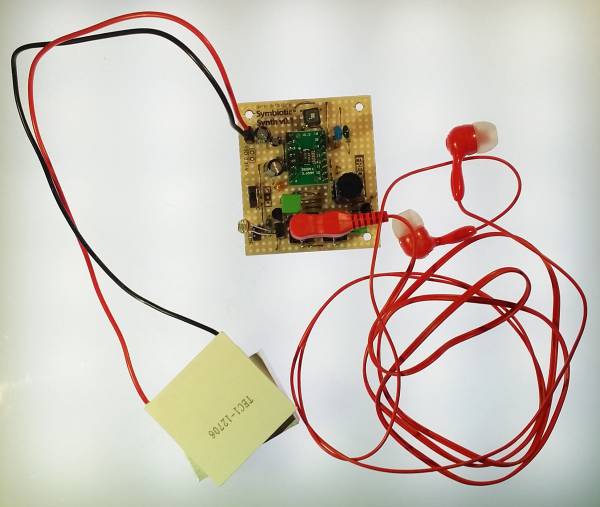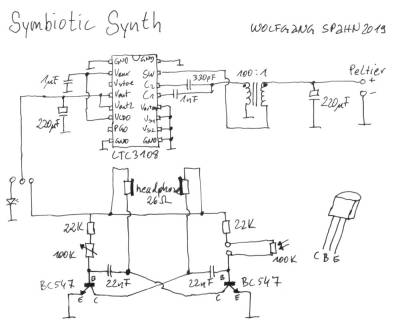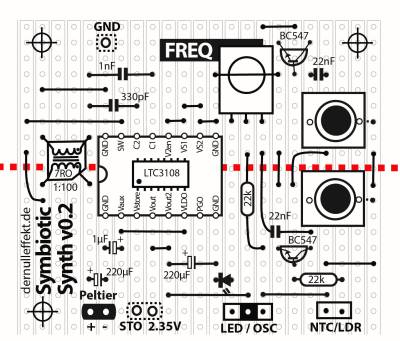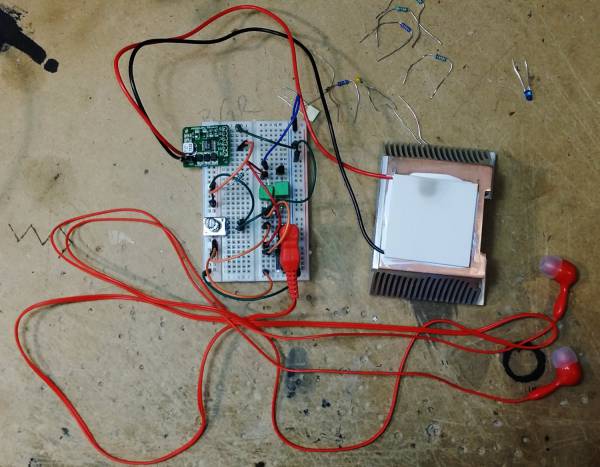Table of Contents
Symbiotic Synth
A self-sufficient audio biofeedback device
The Symbiotic Synth is a low voltage oscillator that is powered as well as controlled by the human body, thus an audible bio-feedback can be made possible.
It was invented and designed by Wolfgang Spahn and was first presented at the workshop I, Machine, and Energy Harvesting by Mindaugas Gapševičius and Wolfgang Spahn as part of the exhibition Shared Habitats in MO Museum, Vilnius, Lithuania in May 2019.
The Symbiotic Synth uses as the only power source the body temperature and drives with that an electric oscillator. The difference of the body to the environment temperature can generates some tiny little bits of electric power - the so called Seebeck Effect. With some tricks and high tech in form of the Small Energy Harvesting Chip: LTC 3108 one can convert that small amount of energy into some decent voltage and an astable multivibrator circuit can be powered with that. It will oscillate in a audible range depending on the setting of the potentiometer. And because the headphone are actually part of the oscillation circuit one can listen to the sound without extra amplification, too.
In attaching some sensors, like: light, pressure, skin and temperature depending resistors to the circuit one can have variations of the sound based on the human body and its functions. The generated sound will change depending on breath, heart beat, skin resistance and body temperature.
With all that both is possible: to power and to modulate a synthesizer with the own human body. And because the generated sound will - like sound always do - stimulate the body function, too, the Symbiotic Synth can be called an self-sufficient audio biofeedback device.
The Symbiotic Synth is part and parcel of the installation Thermal-Acoustic-Seance by Wolfgang Spahn and was shown at the Alliance Francaise Karachi at the Karachi Biennale 2019, Pakistan, with support of the Goethe Institute Pakistan
Schematic
Paper PCB
Here one can find the Paper PCB designs. How to transform them in a real board is described here: Paper PCB Manual. And for the SMD soldering one can find some help here: SMD Solder Manual.
… and don't forget the cut!
Manual
Attach a Peltier elemnet were it's marked on the board - mind the polarity!
When first used the switch should be on LED, and after a little while the LED should light up und the Seebeck effect is generating some power.
One can use that power now to make sound, one has to set the switch on OSC and with the headphones connected one can here some sound - the jumper has to be set.
With the potentiometer one can change now the frequency. If one wants change the sound by using some sensors they have to be connected on the pins instead of the jumper. The best effect will be achieved if one uses sensors with a resistence around 100 KOhm.
The pin on the board with the marking STO can be used for an extra energy storage. A big capacitor should be connected on STO and ground (GND).
But be aware the Symbiotic Synth works with the temperature different from the body to the environment. If that difference is not big enough the Synth will not work. The best results were by temperatures around 25C and lower.
Parts
- Resistors:
- 3x 22 kOhm
- Capacitors:
- 1x 330 pF
- 1x 1 nF
- 2x 22nF
- 1x 1 μF
- 2x 220 μF
- Diodes:
- 1x low current LED
- Semiconductors:
- 2x BC547 transistor
- 1x LTC3108 DC DC converter
- Mechanical:
- 2x adapter board SSOP 16pin
- 2x 8 pin strip
- 1x 2pin strip
- 2x pin header, female 1×2
- 1x jumpers
- 1x mini switch
- 2x mono mini jack socket
- Potentiometers:
- 1x 100 kOhm
- Miscellaneous:
- 1x Peltier element
- 1x cooler
- 1x airplane headphones
LTC 3108 module
In the Symbiotic Synth the LTC3108 and a transformer together with some capacitors are build in.
This part of the circuit has the same functionality like on of the LTC3108 module one find on e-bay:
https://www.ebay.com/itm/Body-heat-energy-harvesting-device/332328658257
Usage of the LTC3108 module
The board has two outputs:
Vout1 with selectable voltage and Vout2 which follows Vout1 in terms of voltage level.
Jumper Setting:

1+3 Vout = 5V 1+4 Vout = 4.1V 2+3 Vout = 3.3V 2+4 Vout = 2.35V
Pinout:
S - additional storage element V1 - Vout1, up to 5mA of output current V2 - Vout2, up to 300mA output current L - LDO G - Ground\\
Links
Acknowledgment
Thanks to Dave Jones of the EEVblog for his great video about Small Energy Harvesting https://www.youtube.com/watch?v=9aSPopIcKLQ.
A great help was the Energy Harvesting Kit by Würth Electronics.
Thanks to Mindaugas Gapševičius for the support.
Supported by Nordic Culture Point.
In cooperation of Institutio Media.
License
This Symbiotic Synth was designed by Wolfgang Spahn 2019.
It is licensed under a Creative Commons Attribution-NonCommercial-ShareAlike 4.0 International License.




